Rick Knabb has been named the new director of NOAA’s National Hurricane Center. He replaces outgoing director Bill Read and begins June 4, days after the official start of the six-month Atlantic hurricane season on June 1.
Well-known as The Weather Channel’s “hurricane expert” for the last two hurricane seasons, Knabb is returning to familiar territory. He was a senior hurricane specialist from 2005 to 2008, and the Center’s science operations officer beginning in 2001.

“I’m ready to reunite with the talented staff at the National Hurricane Center and to work with all of our partners to prepare everyone for the next hurricane,” said Knabb. “Personal preparedness will be critically important, including for my own family and home.”
Born just outside of Chicago, Knabb grew up in Coral Springs, Florida, near Fort Lauderdale, and in Katy, Texas in suburban Houston. He earned a bachelor’s degree in Atmospheric Science from Purdue University and holds a master’s degree and Ph.D. in Meteorology from Florida State University.
Knabb left the Hurricane Center in Miami and became deputy director of the Central Pacific Hurricane Center (CPHC) in Honolulu, Hawaii, for a year before arriving at The Weather Channel. The CPHC oversees tropical cyclone forecasts and warnings from 140° west longitude westward to the International Dateline, including all of the Hawaiian Islands.
A member of the AMS, Knabb also serves on the AMS Board for Operational Government Meteorologists. He has published numerous papers in AMS and other scientific journals and has given presentations on hurricanes and tropical weather at AMS and related conferences. His expertise in communicating has been honed these last two years at The Weather Channel.
“Rick personifies that calm, clear, and trusted voice that the nation has come to rely on,” says NOAA Administrator Jane Lubchenco. “Rick will also lead our hurricane center team and work closely with federal, state and local emergency management authorities to ensure the public is prepared to weather the storm.”
Uncategorized
Cracks in the Ice
Floating ice shelves off the western coast of Antarctica are breaking up at their margins, causing them to disengage from the bay walls where they attach to the coastline and retreat inland. This could cause the fracturing ice to be less capable of preventing grounded upstream ice from sliding into the sea. After studying Landsat satellite data taken of the Amundsen Sea Embayment taken from 1972 to 2011, researchers at the University of Texas examined found extensive changes in the ice shelves over time, including significant fracturing of the margins that bound the shelves. The Embayment is a huge hunk of ice that comprises one-third of the West Antarctic Ice Sheet.
“As a glacier goes afloat, becoming an ice shelf, its flow is resisted partly by the margins, which are the bay walls or the seams where two glaciers merge,” says Ginny Catania, a professor at the University of Texas and coauthor of the study, which was published in the Journal of Glaciology. “An accelerating glacier can tear away from its margins, creating rifts that negate the margins’ resistance to ice flow and causing additional acceleration.”
The video below shows a repeating cycle of the coastline (red line) moving seaward (to the left) and then turning around and moving inland as large ice masses break off. Simultaneously, the northern shear margin breaks up and retreats, thus creating the possibility of an increase of inland ice flow to the sea.
New Warnings, New Words
National Weather Service offices in Missouri and Kansas recently initiated an experiment testing new tornado warnings that combine more specific information with more descriptive language than have been used in the past to describe the potential effects of storms. The experiment is called “Impact Based Warning,” and is meant to bluntly tell residents in the path of tornadoes what could result if they don’t seek shelter. By using phrases such as “complete destruction” and “unsurvivable if shelter not sought below ground,” the NWS is hoping to “better convey the threat and elevate the warning over a more typical warning,” according to Dan Hawblitzel of the Pleasant Hill, Missouri NWS office.
The new alerts got their first big test last weekend when more than 100 twisters were reported in Kansas, Oklahoma, Nebraska, and Iowa. While the NWS’s Storm Prediction Center issued a warning of possible life-threatening storms in several midwestern states days before they touched down, in Kansas the words used in the new alerts were particularly trenchant: “You could be killed if not underground or in a tornado shelter. Many well-built homes and businesses will be completely swept from their foundations.” And the warnings seem to have worked. Despite the large number of storms, only six people were killed—all in an overnight tornado that hit Woodward, Oklahoma. In Wichita, Kansas, a twister tore through a mobile-home park during nighttime hours, but there were no fatalities.
The Impact Based Warning experiment was developed by the NWS in consultation with social scientists. Along with the new vernacular, it includes some key additions to regular tornado warnings, including information that identifies the hazard (hail, winds, tornado, etc.), indicates whether the hazard has been spotted by radar or by people on the ground, and describes potential effects of the hazard (loss of life, damage to trees or buildings, etc.). The warnings can be used not only for tornadoes, but also to signify life- or property-threatening thunderstorms. The experiment is scheduled to run through the end of November, at which point it will be evaluated and considered for more widespread use.
The initiative comes 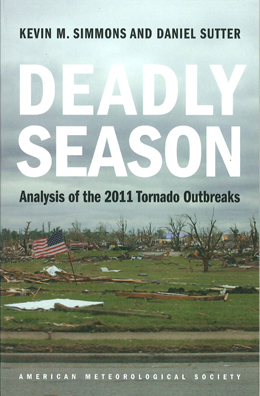 just one year after tornadoes killed more than 500 people in the United States—the deadliest season in almost 60 years. The 2011 year in tornadoes is examined in the new AMS book, Deadly Season: Analysis of the 2011 Tornado Outbreaks, by Kevin M. Simmons and Daniel Sutter. The book is a follow-up to the authors’ Economic and Societal Impacts of Tornadoes, published by AMS in 2011. The new title looks at possible factors contributing to the outcomes of 2011 tornado outbreaks, including assessments of Doppler radar, storm warning systems. and early recovery efforts. Both books can be purchased here.
just one year after tornadoes killed more than 500 people in the United States—the deadliest season in almost 60 years. The 2011 year in tornadoes is examined in the new AMS book, Deadly Season: Analysis of the 2011 Tornado Outbreaks, by Kevin M. Simmons and Daniel Sutter. The book is a follow-up to the authors’ Economic and Societal Impacts of Tornadoes, published by AMS in 2011. The new title looks at possible factors contributing to the outcomes of 2011 tornado outbreaks, including assessments of Doppler radar, storm warning systems. and early recovery efforts. Both books can be purchased here.
A National Network of Networks: The Discussion Continues
by James Stalker, CEO, RESPR, Inc., and Chair, R&D/Testbeds Working Group for the AMS Ad Hoc Committee on a Nationwide Network of Networks
The National Research Council (NRC) report, titled “Observing the Weather and Climate From the Ground Up: A Nationwide Network of Networks (2009),” provided the vision and inspiration for building a team of volunteers from across all three sectors (government, academia, and private) that investigated the
suggestions recommended in the report. This team, comprising six (6) working groups (Organization and Business Models, Architecture, Measurements and Infrastructure, Metadata Policy, R&D and Testbeds, and Human Dimension), spent more than two years considering how to refine the recommendations and tackle the challenges identified in the original NRC report. They also identified other challenges in shaping this type of Nationwide Network of Networks (NNoN), which will be of critical importance to our country’s weather-ready future.
This volunteer team has published additional recommendations compiled into a draft report available at the American Meteorological Society website. Several drafts of this team’s report had been made available to the larger weather and climate enterprise community for comments over many months. The most recent and final version of the report reflects the community input. The readers of this blog are encouraged to read this final report and provide their comments to the Committee Chair and/or any of the Working Group Chairs of the Ad Hoc Committee on Network of Networks.
These volunteer efforts, to date, have certainly tried to solidify the interest of the various stakeholders in a network of this magnitude and of national importance but a lot more work remains to be undertaken. Unfortunately, many challenges remain unresolved. For example, wide-spread support hasn’t been secured for the idea of a central authority for an organizing body of the NNoN. Despite the best efforts by the volunteer team, an appealing organization and business model for such a central body has not been settled on going forward. Other challenges include establishing how to:
- make this organizing body an autonomous body that is not unduly influenced by any one sector,
- make this body a financially sustainable entity in the long run,
- reach all the major stakeholders and get them to support this idea and contribute to its success.
With respect to the third challenge listed above, many of the sought-after stakeholders may not be actively engaged in the weather and climate enterprise community activities and so finding effective ways to reach them becomes an even bigger challenge.
On a positive note, however, the NNoN efforts are going to be discussed again and support will be sought at the AMS Washington Forum in April 2012 and also at the Summer Community Meeting in August 2012 in Norman, Oklahoma. These two venues should prove quite useful for any interested Weather and Climate Enterprise participant and other stakeholders in the overarching effort to build a national asset that the current and many future generations will help nurture and benefit from.
Small Microbes Play Big in Climate Arena
Microbes may be small, but they shouldn’t be ignored when considering global climate. According to a new colloquium report from The American Academy of Microbiology, microbes such as bacteria, algae, and fungi play a powerful role in the Earth’s climate. “Incorporating Microbial Processes into Climate Models” notes how the impact of microbes on the atmosphere goes way back in time. The critical mix of carbon dioxide and oxygen we take for granted as sustaining life on the planet is due to the rise of these tiny creatures eons ago.
So what specifically do these minute forms of life have to do with climate today? According to the report, the answer is plenty. “The sum total of their activity is enormous. But of course not all microbes are the same—some of them are producing oxygen, others are consuming it. Some are taking carbon dioxide out of the air, others are adding it.”
The big questions that the report asks and plans to address by incorporating microbial processes into climate change models: what’s the overall effect of microbial activities on the concentration of carbon dioxide in the atmosphere? Is it possible this activity will absorb the carbon dioxide being added to the atmosphere? Or will the rising global temperature might spur microbes to produce even more carbon dioxide?
The authors recognize that the gap between the climatology and microbiology is large, but they say it is not insurmountable. Some of the same technologies used to collect data for climate models—satellite imaging of cloud cover and precipitation, submarine cables that monitor changes in temperature and salinity, sensors to retrieve real-time data from remote locations—can also be applied to measuring biological phenomena. Collaboration between the sciences, they believe, will benefit both fields.
A more detailed look at the report is available here.
Upping the Ante on Modeling Climate Change Impacts
There is a growing urgency to produce global projections of how a warming climate could affect life on Earth.
“Impact research is lagging behind physical climate sciences,” says Pavel Kabat, director of the International Institute for Applied Systems Analysis (IIASA) in Austria. “Impact models have never been global, and their output is often sketchy. It is a matter of responsibility to society that we do better.”
Time is running out for researchers hoping to contribute impact simulations to the IPCC’s Fifth Assessment Report (scheduled for publication in 2014). So last month, the IIASA and the Potsdam Institute for Climate Impact Research (PIK) started a project to compare climate-impact models collected from more than two dozen research groups in eight countries. The Inter-Sectoral Impact Model Intercomparison Project (ISI-MIP) will integrate climate data from state-of-the-art models, using a range of greenhouse-gas emission scenarios (models used in the project can be found here). Because the various emissions scenarios result in a range of projected global temperature increases, potential impacts also can vary widely across a range of scenarios. It is hoped that the project will clarify systematic biases that can cause models to produce disparate results.
The models will investigate the effects of climate change on global agriculture, water supplies, vegetation, and health. Results are due by July 1, and reports on each of the four impact areas are scheduled to be completed by January of 2013. This means the data could be available for the IPCC’s next report–which “will make a real difference for the assessment process,” notes Chris Field of the Carnegie Institution for Science, cochair of IPCC Working Group II. “I greatly appreciate the initiative required to get this activity underway, and I appreciate the commitment to fast-track components that will yield results in time for inclusion in the IPCC Fifth Assessment Report.”
The ISI-MIP is scheduled to continue into 2013 and could be expanded to analyze climatic impacts on transport and energy infrastructures.
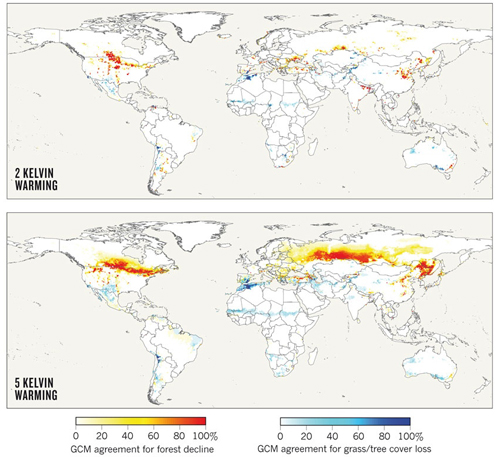
The Zones They Are a-Changin'
The United States Department of Agriculture recently released a map of U.S. planting zones to help gardeners across the country determine what they can and can’t grow. It’s the first new map since 1990, and the changes from the previous map reflect climate variability and change over the last 22 years.
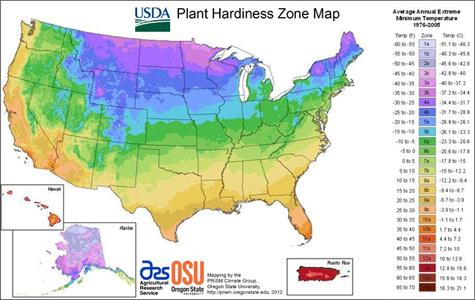
The new map is based on average annual extreme minimum temperatures from 1976 to 2005, whereas the previous map used data from the years 1974-1986. Average temperatures throughout the U.S. were about two-thirds of a degree (F) higher in the more recent time span then they were from 1974 to 1986. As a result, the zones have shifted, and many locations around the country are now in warmer zones than they were on the previous map. Some states, such as Ohio, Texas, and Nebraska, have almost completely migrated to a warmer zone. Of the 34 cities highlighted in the 1990 map, 18 are in warmer zones in the updated version of the map. In general, much of the U.S. is about one-half zone warmer in the new map than in the 1990 edition.
The 2012 version of the planting zones map is the first that is GIS-based. Additionally, a new algorithm used for the 2012 edition enabled more accurate interpolation between weather reporting stations, and the new map also accounts for factors such as elevation changes and proximity to bodies of water, which led to more accurate mapping of the zones. Data used to create the map came from a total of 7,983 stations in the U.S., Canada, and Mexico, including stations of the National Weather Service, the Natural Resources Conservation Service, the Forest Service, the Bureau of Reclamation, the Bureau of Land Management, Environment Canada, and the Global Historical Climate Network.
An in-depth overview of the new map was published in February’s Journal of Applied Meteorology and Climatology. An interactive version of the map and more features can be found here.
Some Good Choices for Your Bookshelf
The Atmospheric Science Librarians International (ASLI) announced their ASLI’s Choice Award winners for 2011 on Wednesday afternoon in the exhibit hall. The awards, now in their seventh year, are presented for the best book of the year in the fields of meteorology/climatology/atmospheric sciences and are judged in the following categories:
- uniqueness
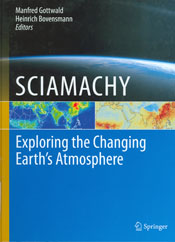
- comprehensiveness
- usefulness
- quality
- authoritativeness
- organization
- illustrations/diagrams
- competition
- references
In keeping with the Annual Meeting’s technology theme, the winning book in the science category was SCIAMACHY: Exploring the Changing Earth’s Atmosphere, edited by Manfred Gottwald and Heinrich Bovensmann, published by Springer. ASLI noted the book provided a “comprehensive summary of the milestone SCIAMACHY mission from its initial conception to most recent results.”
There were two honorable mentions in the science category: The Global Cryosphere: Past, Present and Future, by Roger G. Barry and Thian Yew Gan, published by Cambridge University Press, awarded for “the depth and breadth of its coverage of the major aspects of the cryosphere”; and Physics and Chemistry of Clouds, by Dennis Lamb and Johannes Verlinde, published by Cambridge University Press, for “its data-rich, yet readable exploration of clouds across a range of scales.” 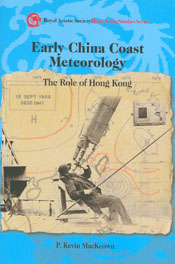
Awards were also given in the history category. The winner was Early China Coast Meteorology: The Role of Hong Kong, by P. Kevin MacKeown, published by Hong Kong University Press, which ASLI lauded for “its account of the scientists and science that comprise the history and accomplishments of the Hong Kong Observatory.” Honorable mention in the history category went to The Warming Papers: The Scientific Foundation for the Climate Change Forecast, edited by David Archer and Ray Pierrehumbert, published by Wiley-Blackwell, awarded “for a compendium of the key scientific papers that undergird the global warming forecast.”
Congrats to all the winners, and it’s never too early to start thinking about next year’s meeting: If you read a good book published this year, you can nominate it for the 2012 award at this page.
Broadcast Meteorology Award Winner Says 'Be Yourself' On-Air
Bob Ryan, meteorologist for WJLA-TV in Washington, D.C., is the 2012 recipient of The AMS Award for Broadcast Meteorology. Ryan is being honored with this annual award in recognition of a career based on personal integrity and dedication to advancing the science of meteorology through broadcasting, education, promotion of safety, and support of colleagues.
Established in 1975, the AMS Award for Broadcast Meteorology recognizes a broadcast meteorologist for sustained long-term contributions to the community through the broadcast media, or for outstanding work during a specific weather event. Ryan, who has been a fixture in Washington TV News for more than three decades, will receive the award at the 92nd AMS Awards Banquet Wednesday evening in New Orleans.
The Front Page caught up with him to learn about how he connects with viewers when on-air and with his colleagues within the AMS. His primary advice for future broadcast meteorologists: “Be yourself,” he says, “and again, you’re talking to one person.” You can view interview below.